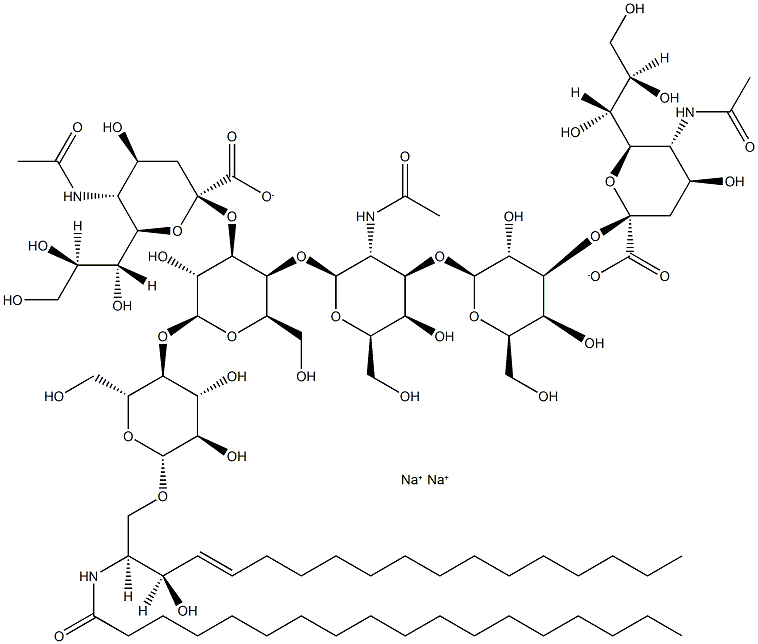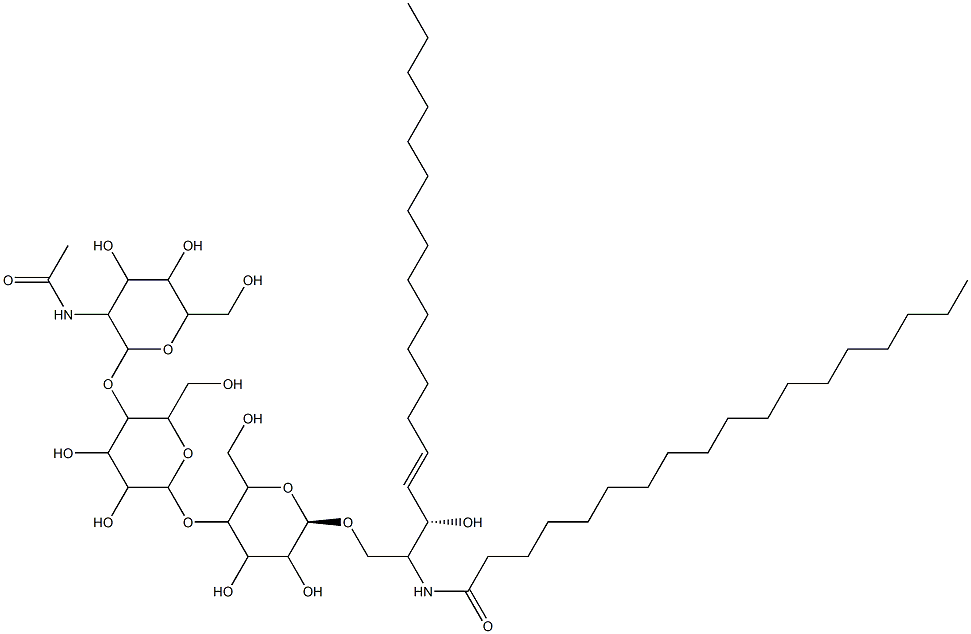C6 CERAMIDE
Synonym(s):C₆ Ceramide;C6 ceramide;Caproyl ceramide;N-Caproyl-D -sphingosine;N-hexanoyl-D-erythro-sphingosine
- CAS NO.:124753-97-5
- Empirical Formula: C24H47NO3
- Molecular Weight: 397.63
- MDL number: MFCD00870174
- SAFETY DATA SHEET (SDS)
- Update Date: 2024-11-19 23:02:33

What is C6 CERAMIDE?
Description
C6 ceramide is a cell-permeable analog of naturally occurring ceramides. With a longer carbon chain than C2 ceramide, it is somewhat more hydrophobic, and may more closely mimic the effects of natural ceramides. C6 ceramide mediates many diverse biological activities including apoptosis, activation of protein phosphatase 2A, and inhibition of the mitochondrial respiratory chain. It also enhances the expression of COX-2 in rat granulosa cells and stimulates the growth of bovine aortic smooth muscle cells. C6 ceramide acts in neuronal axons to inhibit neurite growth.
Chemical properties
Off White Powder
The Uses of C6 CERAMIDE
C6 Ceramide (d18:1/6:0) has been used as a chemotherapeutic agent to test its anti-tumor effect in breast cancer cells and ovarian cancer cell lines. It has also been used to test chemo-sensitization effects in cancer cells.
The Uses of C6 CERAMIDE
A biologically active, cell permeable, but nonphysiologic ceramide analog. It stimulates protein phosphatase 2A at concentrations as low as 10 nM and activiates MAP kinase. It induces apoptosis and inhibits glycoproptein traffic by the secretory pathway.
What are the applications of Application
Ceramide C6 is an ERK activator which arrests cells at the G0/G1 phase.
Definition
ChEBI: N-(hexanoyl)sphing-4-enine is an N-acylsphingosine consisting of sphing-4-enine bearing a hexanoyl group on nitrogen. It is functionally related to a sphing-4-enine.
General Description
Biologically active, cell-permeable, non-physiological ceramide analog. Induces a dramatic arrest in the G0/G1 phase of the cell cycle. Activates MAP kinase. Activates protein phosphatase 2A (PP2A) at 10 nM. Inhibits diacylglycerol accumulation and phospholipase D (PLD) activation in fibroblasts. Induces apoptosis in MOLT-4 leukemia cells.
Biochem/physiol Actions
C6 Ceramide (d18:1/6:0) is involved in inhibiting proliferation and inducing apoptosis. When used in combination with acid ceramidase inhibitor DM102, [(2R,3Z)-N-(1-hydroxyoctadec-3-en-2-yl)pivaloylamide], it favors cell death in human breast cancer cells lines. C6 Ceramide may serve as an adjunct in chemotherapy. It elicits anti-tumor effects via AKT (serine/threonine-specific protein kinase) dephosphorylation and α-tubulin acetylation.
Properties of C6 CERAMIDE
| Melting point: | 76-77°C |
| Boiling point: | 521.03°C (rough estimate) |
| Density | 1.0077 (rough estimate) |
| refractive index | 1.6000 (estimate) |
| storage temp. | -20°C |
| solubility | Soluble in 100% ethanol at 25mg/ml and also in DMSO at 50mg/ml. |
| form | Powder |
| pka | 13.53±0.20(Predicted) |
| color | White |
| Stability: | Freezer -20°C |
Safety information for C6 CERAMIDE
| Signal word | Warning |
| Pictogram(s) |
 Exclamation Mark Irritant GHS07 |
| GHS Hazard Statements |
H315:Skin corrosion/irritation H319:Serious eye damage/eye irritation H335:Specific target organ toxicity, single exposure;Respiratory tract irritation |
| Precautionary Statement Codes |
P261:Avoid breathing dust/fume/gas/mist/vapours/spray. P271:Use only outdoors or in a well-ventilated area. P280:Wear protective gloves/protective clothing/eye protection/face protection. |
Computed Descriptors for C6 CERAMIDE
New Products
Tert-butyl bis(2-chloroethyl)carbamate (S)-3-Aminobutanenitrile hydrochloride N-Boc-D-alaninol N-BOC-D/L-ALANINOL N-octanoyl benzotriazole 3,4-Dibenzyloxybenzaldehyde 4-Hydrazinobenzoic acid Electrolytic Iron Powder 1,1’-CARBONYLDIIMIDAZOLE R-2-BENZYLOXY PROPIONIC ACID 4-HYDROXY BENZYL ALCOHOL 1,1’-CARBONYLDI (1,2-4 TRIAZOLE) S-2-CHLORO PROPIONIC ACID (2-Hydroxyphenyl)acetonitrile 4-Bromopyrazole 5-BROMO-2CYANO PYRIDINE 5,6-Dimethoxyindanone 5-broMo-2-chloro-N-cyclopentylpyriMidin-4-aMine 3-(2,4-Dimethoxybenzyl)dihydropyrimidine-2,4(1H,3H)-dione 6-Bromo-3-iodo-1-methyl-1H-indazole N-Boc-L-proline methyl ester 2-(BOC-Amino)4-picoline 1-(4-Methylphenylsulfonyl)-1H-1,2,3-benzotriazole 1-(2-Chlorobenzyl)-4-nitro-1H-pyrazoleRelated products of tetrahydrofuran




![N-[12-[(7-NITRO-2-1,3-BENZOXADIAZOL-4-YL)AMINO]DODECANOYL]-CERAMIDE](https://img.chemicalbook.in/StructureFile/ChemBookStructure5/GIF/CB4309134.gif)


![NBD HEXANOIC CERAMIDE,N-[6-[(7-NITRO-2-1,3-BENZOXADIAZOL-4-YL)AMINO]CAPROYL]-CERAMIDE,NBD C6-CERAMIDE](https://img.chemicalbook.in/CAS/GIF/86701-10-2.gif)
You may like
-
 C6 Ceramide (d18:1/6:0) CAS 124753-97-5View Details
C6 Ceramide (d18:1/6:0) CAS 124753-97-5View Details
124753-97-5 -
 D-erythro-Sphingosine, N-Hexanoyl- CAS 124753-97-5View Details
D-erythro-Sphingosine, N-Hexanoyl- CAS 124753-97-5View Details
124753-97-5 -
 N-Hexanoyl-D-sphingosine CAS 124753-97-5View Details
N-Hexanoyl-D-sphingosine CAS 124753-97-5View Details
124753-97-5 -
 Ste-Glu-AEEA-AEEA-OSUView Details
Ste-Glu-AEEA-AEEA-OSUView Details
1169630-40-3 -
 1446013-08-6 Fmoc-His-Aib-OH TFA 98%View Details
1446013-08-6 Fmoc-His-Aib-OH TFA 98%View Details
1446013-08-6 -
 127464-43-1 99%View Details
127464-43-1 99%View Details
127464-43-1 -
 2-ETHYLPYRIDINE 100-71-0 99%View Details
2-ETHYLPYRIDINE 100-71-0 99%View Details
100-71-0 -
 13162-05-5 99%View Details
13162-05-5 99%View Details
13162-05-5